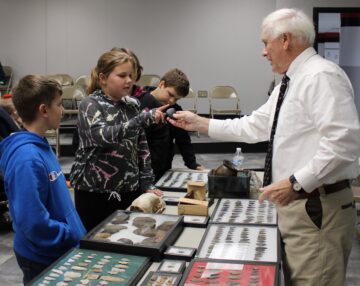‘Ghosts of the Mountains’ explores early Native Americans

Mr. Stahl, a retired MAHS educator, visited fifth grade students in September 30 as part of a social studies unit called “The First Americans.” During his presentation, Stahl shared information and allowed students, including Lealand Butler, Leahanna Walters and Hayden Gray, to examine his extensive collection of Indian artifacts, including items identified as belonging to Monongahela Indians, who called this region their home from approximately 800 to 1500 B.C.
Stahl annually presents a program entitled “The Ghosts of the Mountains” in conjunction with a unit taught in Social Studies by Amanada McNelly. McNelly said Stahl’s presentation is a perfect compliment to a unit entitled “The First Americans.”
“Students are currently learning about the Bering Land Bridge, the migration of the first nomads, and the settlement of the natives into North and South America. When Mr. Stahl visits our school, it helps the students make connections and learn more about the Monongahela Indians that inhabited the area where we live now,” explained McNelly.
Stahl explained to the students that the Monongahela people lived in this area, and had several villages along the Casselman and other waterways in the region. Evidence of their villages and remains was discovered in the 1930s when the Works Progress Administration assigned teams of archeologists to explore this region. Locally, three major sites were found in Meyersdale, Confluence and the Stonycreek area. The work was completed under the watchful eye of Mary Butler, the archeologist in charge of the excavations completed in this area. Butler determined the artifacts being discovered were not of known tribes, but of a newly discovered people she named Monongahela, based on the creeks and rivers that lead to the Monongahela River.
“The Monongahela lived right where we are, you can walk out the doors and find a village where they once lived,” Stahl explained. “The first site ever recorded was here in Somerset County.” Stahl said the sites found locally were discovered during WPA projects completed in this region by local residents facing employment challenges.
“In the chapter we are covering in Social Studies, ‘The First Americans,’ students read about a variety of artifacts from the time period, the homes the Indians built, and the food that was hunted/gathered. Mr. Stahl revisits those concepts when teaching about the local natives as well,” McNelly added. “The Monongahela spent almost all of their time looking for or hunting for food, survival was very difficult and most only lived to be in their 40s.”
By the 1500s, the Monongahela disappeared entirely, leaving only traces to be found hundreds of years later. Stahl said many factors conspired to eradicate the Monongahela from existence – disease, other tribes, over-hunting and a dramatic climate change.
“Many things went wrong at the same time. The temperatures were getting colder and began to affect their crops, which led to more hunting, which led to fewer animals. Groups began fighting with each other and there is evidence that the Seneca and Iroquois may have come through and killed many of the Monongahela people,” he explained. “European settlers started coming to the region, bringing with them diseases the Monongahela could not survive. It’s important that we know and remember they were here and how difficult their lives were and how hard it was for them to survive as long as they did.”
Following his presentation, Stahl allowed the students to examine pieces of his extensive collection of artifacts. He also fielded questions from the students.

